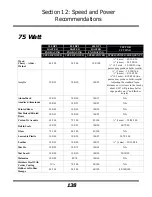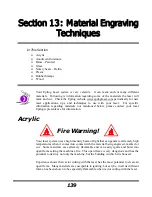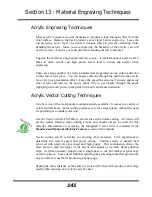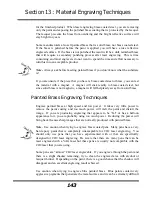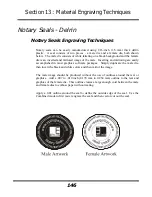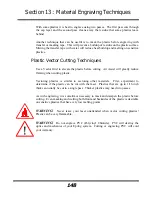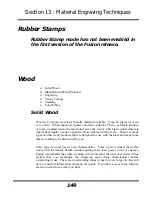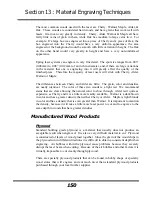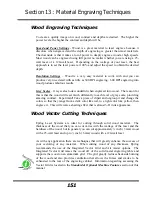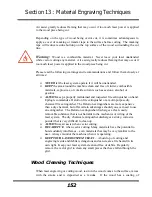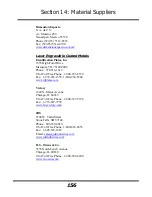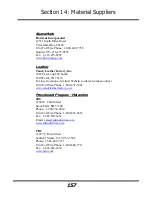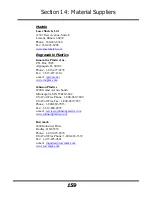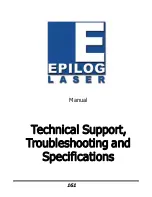
Section 13: Material Engraving Techniques
147
Plastic
Plastic Background
Engraving plastics have changed greatly in the past few years. Before lasers, plastic
manufacturers designed plastic for rotary engraving systems. A rotary engraving
system uses a mechanical spinning bit to remove material. Therefore the depth of the
top layer or “cap sheet” was designed to make it easy to rotary engrave. Cap sheet
thickness was approximately .010 inches (0.254 mm) thick and laser engraving was
nearly impossible because by the time you applied enough power to get through the
cap sheet the laser melted and deformed the plastic.
Plastic manufacturers have developed a broad range of plastics that have thinner cap
sheets that are .002 to .003 inches (0.051 mm to 0.076 mm) thick that provide much
better engraving and cutting characteristics. These plastics are commonly referred to
as Micro Laminates; Micro surfaced, or simply laser engravable plastics. These
plastics are generally very easy to engrave with a laser since they all have similar
characteristics.
Because there is such a broad range of plastics it is necessary to experiment to
determine if a particular type of plastic is laser compatible. Different color plastics,
even if they are from the same manufacturer will have unique speed and power
settings. Use the guidelines in this manual as a starting point when determining the
correct speed and power settings. If you do not get acceptable initial results with the
recommended speed and power settings start experimenting by first changing only the
power setting. If adjusting the power setting does not work, start over and adjust only
the speed setting. Once you have acceptable results, record those settings for that
particular plastic so that you do not have to repeat the experimentation process.
Plastic Engraving Techniques
Always remove the clear protective cover layer before engraving.
Once you have the correct speed and power settings you can improve your engraving
results even more by taking the focus lens out of focus (lower the table) by about 1/16
(1.5 mm) of an inch. This technique enlarges the focus beam a little bit and provides
more beam overlap on each pass of the laser. The greater overlap produces a
smoother engraved surface on the plastic and eliminates the grooves that you
sometimes see when engraving plastic.
Summary of Contents for Fusion 13000
Page 2: ...ii THIS PAGE WAS INTENTIONALLY LEFT BLANK ...
Page 4: ...Contents at a Glance iv THIS PAGE WAS INTENTIONALLY LEFT BLANK ...
Page 8: ...Table of Contents viii INDEX 195 THIS PAGE WAS INTENTIONALLY LEFT BLANK ...
Page 10: ...Fire Warning x SEE PREVIOUS PAGE ...
Page 14: ...Introduction xiv THIS PAGE WAS INTENTIONALLY LEFT BLANK ...
Page 15: ...1 Manual Epilog Laser Setup ...
Page 16: ...2 THIS PAGE WAS INTENTIONALLY LEFT BLANK ...
Page 26: ...Section 1 Safety 10 ...
Page 27: ...Section 1 Safety 11 ...
Page 28: ...Section 1 Safety 12 THIS PAGE WAS INTENTIONALLY LEFT BLANK ...
Page 41: ...Section 3 Getting Started 11 THIS PAGE WAS INTENTIONALLY LEFT BLANK ...
Page 44: ...Section 4 Installing the ECC 14 ...
Page 51: ...Section 4 Installing the ECC 21 THIS PAGE WAS INTENTIONALLY LEFT BLANK ...
Page 58: ...Section 5 Installing the Epilog Dashboard Print Driver 28 10 Click on Update Driver ...
Page 68: ...Section 5 Installing the Epilog Dashboard Print Driver 38 Click on Add Local Printer ...
Page 108: ...Section 6 Using the Epilog Dashboard 78 THIS PAGE WAS INTENTIONALLY LEFT BLANK ...
Page 109: ...79 Manual Basic Operations ...
Page 110: ...80 THIS PAGE WAS INTENTIONALLY LEFT BLANK ...
Page 130: ...Section 8 Using the Front Control Panel 100 THIS PAGE WAS INTENTIONALLY LEFT BLANK ...
Page 136: ...Section 9 Using the ECC Epilog Control Center 106 THIS PAGE WAS INTENTIONALLY LEFT BLANK ...
Page 148: ...Section 10 Standard Optional Machine Features 118 ...
Page 152: ...Section 11 Engraving Machine Cleaning 122 Crash Bar and locating pins ...
Page 160: ...Section 11 Engraving Machine Cleaning 130 ...
Page 184: ...Section 13 Material Engraving Techniques 154 THIS PAGE WAS INTENTIONALLY LEFT BLANK ...
Page 191: ...161 Manual Technical Support Troubleshooting and Specifications ...
Page 192: ...162 THIS PAGE WAS INTENTIONALLY LEFT BLANK ...
Page 194: ...Section 15 In Case of Difficulty 164 THIS PAGE WAS INTENTIONALLY LEFT BLANK ...
Page 200: ...Section 16 Specifications 170 THIS PAGE WAS INTENTIONALLY LEFT BLANK ...
Page 208: ...APPENDIX A 178 THIS PAGE WAS INTENTIONALLY LEFT BLANK ...
Page 218: ...Appendix C Additional Dashboard Instructions 188 ...






